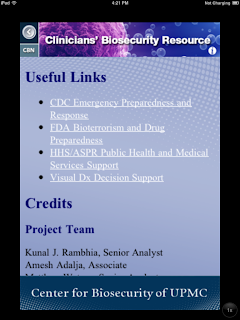The
Clinicians Biosecurity App for healthcare providers from the
Center for Biosecurity of UPMC is one app you'll want before your next shift.
 |
| Home screen on iPad |
The
Center for Biosecurity of UPMC has released their latest app for iOS. The Clinicians Biosecurity Resource (CBR) App covers the basics of several diseases with feature rich content for further leaning. CBR easily overpowers their prior offering,
BioAgent Facts app. Click
here for my review of the
BioAgnet Facts app.
 |
| Disease list on iPad |
The
CBR app covers six diseases with enough detail to make this a worthwhile reference to assist in the recognition of a naturally occurring or intentional biologic event. The information for each pathogen is broken down into categories and is referenced to fact sheets from the
Centers for Disease Control and Prevention (CDC) and he Center for Biosecurity. The value of the CBR app is increased substantially by the addition of sections for each pathogen on naturally occurring states, post exposure prophylaxis, personal protective equipment (PPE). The content is digestible, concise, and easily accessed through the apps interface. Images of x-ray findings are included (see Anthrax below).
 |
| Access to Biosecurity News |
 |
| Notification option |
You can also access
Clinicians Biosecurtiy News (CBN), published twice monthly, directly from the home screen. Clicking on the wrench icon on the CBN page provides an option to be reminded about CBR updates. The information icon (
i) links to the 'about' page containing a disclaimer, developer credits and additional links for reference.
Typical bioagent page layout shown below (Anthrax page as example)

The
Clinicians Biosecurity Reference (CBR) will be useful for emergency medical service professionals, nursing, as well as physicians. The layout/design and feature rich content take this app above and beyond. Navigation and user interface are simple and CBR runs smoothly on iPhone/iPad running iOS 5.0.1. The color scheme is much easier to read than BioAgent Facts.
I highly recommend the CBR app.
Final Score 0-5: The CBR app gets a
4.5
Content: 4.5 Solid information from a trusted resource, easy to access and scan. External links to CDC and Biosecurity News add value. CBR app can go a long way being used as reference and learning tool. Dumping the Zombie section (as seen in BioAgents Facts) and adding sections for
Naturally Occurring, PPE, and Post Exposure information is a major improvement.
Aesthetics/graphics: 4.0 Detailed graphics and color combinations that are easy on the eyes.
Ease of Use: 4.5 I
found the tabs/buttons easy to navigate. Text is clear with pleasing color combinations. Stable on an iPhone/iPad (iOS 5.0.1)
there is no clear support/FAQ available.
Wishlist for CBR:
Allow screens to rotate. This would be especially helpful for iPhone.
Enable gestures. Again, a big advantage for iPhone









